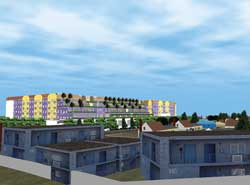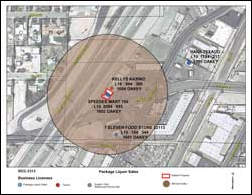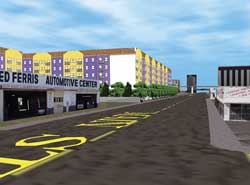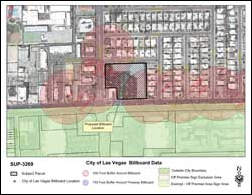Guiding Growth in Booming Las Vegas
 |
| Three-dimensional models assist city planners in finalizing the details of major projects and the standards for long-range planning documents. |
Technology and smart planning techniques have allowed the Planning Department for the city of Las Vegas, Nevada, to improve customer service, utilize instant access to information, and enhance the quality of life for both visitors and citizens of Las Vegas.
Las Vegas' population grew 73 percent between 1990 and 2000. The population topped 500,000 in 2000, and by 2020, the population is expected to increase to 800,000. How can Las Vegas accommodate growth while enhancing the city's quality of life and livability? Maintaining a vibrant and growing community with a strong economy while addressing air and water quality issues and redeveloping older areas presents many planning challenges.
Mapping Future Growth
To meet these challenges, the city began preparing a new Master Plan that would supply comprehensive policy direction for future land use decisions and urban planning for the city through 2020. The Master Plan will provide guidance for city staff, the planning commission, and the city council in planning-related decisions as well as a readable, handy reference for the development community and general public.
Development of the Master Plan included two rather innovative efforts-a community vision survey and the use of GIS models. With these models, planners can test the effects of land use allocation, traffic, air quality, and property tax assessment changes. With these models, planners can also test the effectiveness of the Master Plan's goals, objectives, and policies by visualizing and predicting policy outcomes and determining if policy interventions would enable the city to accommodate growth.
Enhanced Regional Coordination
Given the geography of the Las Vegas Valley and the interrelated roles of municipal and regulatory organizations in the area, it was important that these entities work together to resolve regional issues. A regional GIS repository gives all entities access to GIS data and maps relating to air and water quality, education, transportation and transit issues, parks and trails, affordable housing, water usage, utility services, flood control, and homeless and public safety issues.
 |
| Printed maps are distributed at town hall meetings. |
The city relies on a variety of GIS tools and data collection techniques to keep up with data maintenance. These tools have enhanced productivity and accuracy as well as capturing more information than was previously possible. Aerial photographs are taken twice a year. Using GPS with ArcPad, GIS data collection applications have significantly reduced training time and improved the amount of data collected by approximately 500 percent. Videos of interior sewer pipe walls are available at the click of a button from GIS desktop applications. Signs, billboards, historic areas, business types, land use, building footprints, and separation distance data are similarly accessible.
Effective Data Access
ArcGIS has been installed on every personal computer in the planning department. All staff members have been trained and can competently use ArcGIS. Custom applications give planning employees and citizens instant access to the city's abundant planning information. Using desktop GIS eliminates the need for hard-copy maps. Research can now be carried on more efficiently with improved accuracy that yields consistent information. With GIS, staff responding to inquiries can let customers see the answers to their questions. The result: The public has a better understanding and more actively participates in the planning process.
Mapping information is embedded in almost every area of the planning process and is delivered in several mediums.
- Citizens use the Internet to access interactive GIS services as well as downloadable static maps.
- Printed maps are distributed at town hall meetings.
- Interactive three-dimensional fly-through demonstrations of proposed developments are delivered on CD-ROM or presented live during televised public meetings.
Better Decision Making
Citizen participation is an important part of the planning process. Basemaps are generated for planning charts. The aerial photographs of subject areas are displayed and televised during planning commission or city council meetings giving citizens a better idea of location of the proposed project under consideration.
 |
| Three-dimensional models, made by combining GIS and project site plan data with photos of architectural and landscaping details, demonstrate the impact of significant projects and assist in planning decisions. |
The three-dimensional models assist city planners in finalizing the details of major projects and the standards for long-range planning documents. The models—made by combining GIS and project site plan data with photos of architectural and landscaping details—facilitate discussions between staff, city officials, and the public. Three-dimensional models demonstrate the impact of significant projects and assist in planning decisions.
Planning commissioners and city council members have a wealth of information available including an assortment of color maps-aerial, land use, zoning, and separation distance. These maps, showing nearly every aspect that would impact a project, furnish commissioners and council persons with ample support for decision making.
Planning commissioners also have access to ArcGIS during meetings and are able to view planning-related information for any area. Council members' computer screens are visible to the audience, other council members, and commissioners and are also televised. Former City Councilman Arnie Ademsen believes that having instant access to information via GIS allows members to make faster decisions. Before GIS, certain items were postponed so that further research could be performed.
Partnering for Success
 |
| Maintaining a vibrant and growing community with a strong economy while addressing air and water quality issues and redeveloping older areas presents planning challenges. |
Partnering with the city's IT department ensures the planning department spends its time focused on planning, quality service, and public outreach with the knowledge the department's information systems are secure, managed, and backed up. Before joining forces with the IT department, data backups and hardware maintenance were done by planners or GIS staff. Now GIS staff can concentrate on producing better deliverables in an efficient and effective manner, which makes for a competitive public planning agency.
|